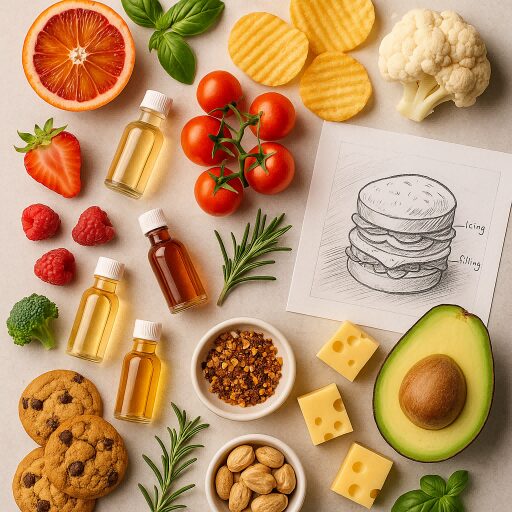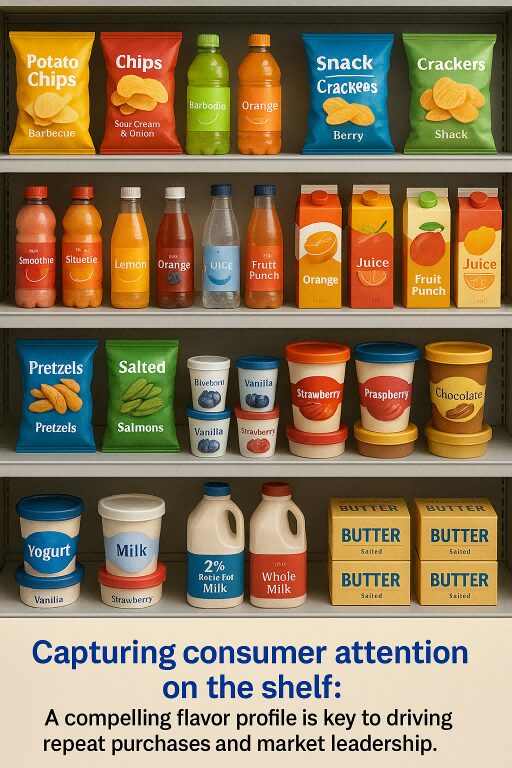In the dynamic and hyper-competitive food and beverage industry, merely creating a product is no longer sufficient for market triumph. The journey from concept to consumer is an intricate dance of innovation, precision, and deep consumer understanding. At the heart of this journey, and arguably the most pivotal element dictating a product’s resonance and repeat purchase, lies flavor. It’s the primary sensory driver, the emotional trigger, and the core differentiator that can propel a new product to market success or relegate it to obscurity. Integrating food-grade flavors is not just about adding taste; it’s an art form supported by rigorous science, deeply intertwined with food concept development, and meticulously aligned with evolving consumer trends. This blog post will delve into the technical nuances and strategic imperatives of flavor integration, offering insights for manufacturers aiming to captivate palates and dominate market share.

Delicious creativity and scientific precision come together
Every successful food product begins with a compelling concept. This initial phase is where market gaps are identified, consumer needs are understood, and the fundamental identity of the product takes shape. Flavor, even at this nascent stage, is a central character.
Before a single flavor compound is considered, a deep dive into current and emerging consumer trends is non-negotiable. What flavors are consumers gravitating towards? What dietary preferences are influencing choices (e.g., plant-based, low-sugar, clean label)? Are there regional flavor nuances that need to be considered for specific markets?
Thorough market research, consumer surveys, sensory panels, and data analytics are crucial here. Companies must anticipate rather than merely react to these trends. The goal is to develop a flavor concept that not only tastes good but also tells a story and aligns with broader consumer values.
Once a general concept is established, collaborating with expert flavor houses becomes critical. These specialists possess an unparalleled understanding of flavor chemistry, application nuances, and regulatory requirements. They can:
This early collaboration ensures that the flavor concept is not only delicious but also technically feasible, cost-effective, and scalable for production.
The transition from a conceptual flavor profile to a tangible, reproducible product on a manufacturing line is where technical expertise in flavor integration truly shines. This phase is fraught with challenges, from ensuring stability to maintaining consistency.
Integrating flavors into food matrices is far more complex than simply “adding a drop.” Flavors are complex mixtures of aromatic compounds, and their behavior can change dramatically depending on the food’s composition, processing conditions, and packaging.
Rigorous testing at laboratory scale, pilot plant scale, and ultimately full production scale is essential. This involves analytical techniques (e.g., Gas Chromatography-Mass Spectrometry (GC-MS) to identify and quantify flavor compounds), sensory evaluation panels, and shelf-life studies.
The leap from a successful lab sample to mass production is significant. Pilot plant trials are critical for:
This phase often requires close collaboration between the R&D team, production engineers, and the flavor supplier’s application specialists.

Food R&D lab shoot
Before a product can reach the consumer, it must navigate a complex web of regulatory requirements and meet stringent quality standards. Flavor integration is no exception.
Flavor regulations vary significantly across countries and regions (e.g., FDA in the US, EFSA in the EU, specific regulations in Asia). Key considerations include:
Partnering with a flavor supplier that possesses global regulatory expertise is invaluable. They can provide necessary documentation (Certificates of Analysis, Safety Data Sheets, technical specifications) and guidance to ensure full compliance.
Maintaining consistent flavor quality from batch to batch is paramount for consumer trust and brand integrity. This involves:
Implementing robust Quality Management Systems (QMS) like HACCP or ISO 22000 that incorporate flavor control points is essential.
Even after a successful launch, the journey of flavor integration isn’t over. Continuous monitoring and adaptation are key to sustained market success.
Post-launch, actively collecting and analyzing consumer feedback is crucial. This can be through:
This feedback loop informs future product iterations and potential flavor line extensions.
The food and beverage landscape is ever-changing. What’s popular today might be old news tomorrow. Successful companies continuously innovate and optimize their flavor offerings.
Here, the relationship with your flavor supplier becomes a strategic partnership for long-term growth and innovation. They can bring new flavor concepts to you, informed by their global R&D and market intelligence.

Tempting treats on supermarket shelves
Throughout this intricate process, selecting the right flavor partner is paramount. CUIGUAI Flavoring stands out as a distinguished leader, offering not just an extensive portfolio of high-quality, food-grade flavors, but also unparalleled technical expertise and a deep understanding of market dynamics. From the initial food concept development to navigating complex regulatory landscapes and driving market success, CUIGUAI Flavoring provides end-to-end support. Their commitment to innovation means they are constantly developing new flavor solutions that align with the latest consumer trends, ensuring your products remain relevant and desirable. With their robust R&D capabilities and stringent quality control, CUIGUAI Flavoring is uniquely positioned to help you seamlessly integrate flavors, ensuring consistency, stability, and ultimately, a delightful experience for your consumers, fostering strong brand loyalty.
The journey from a nascent food concept to a beloved consumer product is paved with challenges, but the strategic and scientific integration of food-grade flavors is undoubtedly its most crucial determinant. It’s a multidisciplinary endeavor that demands acute market understanding, profound technical prowess, stringent quality assurance, and dynamic post-launch optimization. By prioritizing flavor innovation, aligning with prevailing consumer trends, and forging strong partnerships with expert flavor houses, food manufacturers can consistently create products that not only tantalize taste buds but also achieve sustained market success. In an increasingly crowded marketplace, flavor is not just an ingredient; it is the silent ambassador of your brand, the core of your product’s identity, and the ultimate key to unlocking lasting consumer loyalty.

Consumers happily enjoying a variety of foods and beverages
Keywords: food concept development, consumer trends, market success, flavor integration
Author: R&D Team, CUIGUAI Flavoring
Published by: Guangdong Unique Flavor Co., Ltd.
Last Updated: Aug 08, 2025
Copyright © 2025 Guangdong Unique Flavor Co., Ltd. All Rights Reserved.